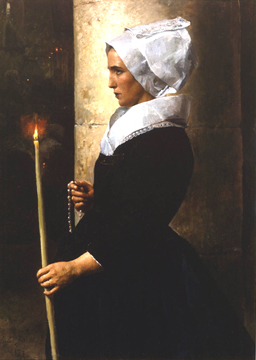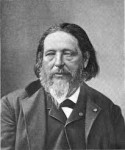
Jules Breton
French, 1827-1906
The Pardon, 1872
oil on canvas
47 5/8 x 34 in.
SBMA, Gift of Kenneth W. Watters in memory of Elizabeth Converse Strong Watters
1989.43

Undated photo of Breton.
RESEARCH PAPER
Jules Breton was possibly the most successful and famous painter of his time, yet in terms of the history of art he has been all but forgotten. He has been judged harshly as a "hack" of the Salon and has been overshadowed by other artists of the period who are considered more original and innovative. A renewed interest in his work has surfaced in the last decade and a review of his life, times and body of work reveal some insights into his particular vision. This review reveals the strength and sincerity of this vision within the context of his times and his unique personality.
Breton was born into the landed bourgeoisie but he had close contact throughout his life with the peasants of his native village of Courrieres. He considered himself a man of the earth. The roots of his artistic vision were in his childhood experiences with the peasants and these experiences gave him a deep understanding of the people and their traditions. As a young man he was sent to study art in Belgium. He received formal, academic training in the neoclassical style of the time. This style dictated that subject matter be historical or religious with an eye to the forms and principals of classical antiquity. This training emphasized a polish and structure that Breton adhered to throughout his career. Breton was also influenced by the Old Flemish Masters like Rogier Van Der Weyden and Jan Van Eyck. These influences can be seen in our painting, The Pardon.
In 1848 Breton went to Paris where the social and political climate had a profound influence on his life and art. A series of revolutions had radically changed the government of France, resulting in urbanization, industrialization and agarian capitalism. Even as the July Revolution of 1830 sought to abate class antagonisms and unite France as "The People", the polarity of urban and rural though created antagonism and revolt among the peasants. It was within this atmosphere of government seeking to ignore the plight of the peasants while glorifying them as the symbol of France that Jules Breton worked as an artist. He was to become a favorite of the government sponsored Salon because his depictions revealed the life and traditions of a France that remained virtually unchanged since the Middle Ages. This changing life was not what the ruling government wanted to see, they sought instead to celebrate and idealize rural institutions even as they were threatened.
Breton and his contemporaries were not the first to depict peasants. Previously peasants were painted in a romanticized way with allusions to classical or Biblical references. Dutch painters stereotyped peasants as ruffians or drunks (1). It was with Breton and the French Realists that the laboring classes, as themselves, became elevated to subject matter for fine art. Breton's earliest work in Paris was a means of social protest. Along with Millet and Courbet, he sought to give serious treatment to the commonplace and to reveal the disasterous effects of political change upon the poor. About this time he was forced to return to his village and it was then that he realized his committment to depicting the rural countryside. But while the realist avante-garde went on to depict the countryside as poor and harsh, Breton was to portray a monumental yet humble peasant. It was his great skill at depicting an image that was anchored in reality yet idealized that was to make him a favorite of the Salon. This balance of the real and ideal is evident in The Pardon.
In the 1860's Breton's style, with the encouragement of the Salon, became more classic, his compositions more simplified and colors muted. Except for the subject matter, his art conformed to the academic teaching of the day (2). His style at this time also reflected a change in his tonal range toward brilliant light and deeper colors (3). He was a master at using the effects of light but he was concerned less with depicting external reality than in conveying a mood. These stylistic features are all revealed in The Pardon.
It was also at this time, in 1865, that Breton made his first trip to Brittany. It was in observing this annual mystical pilgrimage, the last vestige of the Feast of the Dead, that Breton found a subject matter he considered to be truly French. It was from this trip that he developed a keen interest in folklore and ethnography, qualities highly valued by the Realist Tradition (4).
Breton also travelled to Italy and saw the frescoes of Michaelangelo and Raphael. The influence of these masters can be seen in the individualizing of his subjects and a shift to a grander scale. It is in this -style of a single figure, individualized, on a grand scale, proud and beautiful yet working the land, pious and solemn, into which The Pardon falls.
The importance of the pardon imagery to Breton lies not only in its use as subject matter but in its rendering. Many artists were attracted to this region. It seemed to be especially untouched by time. It drew larger crowds of pilgrims for a more spectacular display of garments and ceremony than seen elsewhere. It was Breton who rendered so effectively the importance of these ceremonies to the people of Brittany. Every element of his compositon in The Pardon reinforces the dignity and mystery that he seeks to project. The strong, simple composition emphasizes the woman and her piety. We observe her but we cannot participate in her reality. Breton gives special attention to her expression which adds to her dignity and beauty. Although she is idealized, Breton has anchored her in reality. He does this via the meticulous rendering of her garments and the rough rendering of her hands, where we see the dirt beneath her nails. His palette also lends a sense of piety and mystery. These solemn, rich colors set the mood for the piece. Sketchily rendered figures emerge from the dark interior adding to sense of mystery and importance in this scene. The only apparent source of light seems to be a single taper yet the figure and column are too brightly lit for a candle to be the only source of light. The taper itself takes on an importance as a warm tone among cold, dark colors.
The work of Jules Breton influenced not only the artists of his time such as Millet but was admired by later artists such as Van Gogh and Pissarro. His attempts to transform peasants into the heroes of nineteenth century France sprung from a deep belief that they were worthy of such respect and glorification. The fact that his depiction of a rural ideal was encouraged and embraced by the bourgeoisie does not diminish his belief in the validity of this vision. His skill at rendering reality yet stirring the emotions fit into the academic prescriptions of the day and he was content to work within its confines.
Footnotes:
1. Hollister Sturges, Jules Breton, Creator of a Noble Peasant Image. (Joslyn Art Museum, 1987), p.23.
2. Hollister Sturges, Jules Breton and the French Rural Tradition (Joslyn Art Museum, 1982), p.15.
3. Gabriel Weisberg, French Painting and Drawing 1830-1900 (Cleveland Museum of Art, 1980), p.19.
4. Ibid, p.12.
Prepared for the Santa Barbara Museum of Art Docent Council by Ronda Quaid, April 5, 1991.
BIBLIOGRAPHY
Cleveland Museum of Art, Cleveland, Ohio. 'The Realist Tradition: French Painting and Drawing 1830 - 1900," 1980.
Joslyn Art Museum, Omaha, Nebraska, "Jules Breton and the French Rural Tradition," November 6, 1982 - January 2, 1983.
Joslyn Art Museum, Omaha, Nebraska, "The Rural Vision. France and America in the Late Nineteenth Century," November, 1982.
Varnedoe, Kirk, "Realism's Second String ," Art in America, September, 1981, pp. 134 - 141.
Weisberg, Gabriel, "Jules Breton, Jules Bastien-Lepage and Camille Pissaro in the Context of Nineteenth Century Peasant Painting and the Salon," Arts Magazine, Vol. 56, February, 1982, pp. 115 - 119.
Weisberg, Gabriel, "Vestiges of the Past: The Brittany Pardons of Late Nineteenth Century French Painters," Arts Magazine, Vol. 55, February, 1980, pp. 34 - 38.

Peasant Woman Holding a Taper (circa 1869), Bridgeman Art Library / Brooklyn Museum of Art, New York, USA.
SBMA CURATORIAL LABELS
Breton is typically categorized as an academic French painter because of the decorousness of his figures and his polished brushwork. But to Van Gogh, Breton’s depictions of the peasantry were far from just picturesque idealizations. In 1880, Vincent even made a pilgrimage to northern France, where Breton lived and worked, to garner inspiration for his own budding aspiration to capture “the typical and picturesque figures of the workmen: different diggers, woodcutters, a farm-hand driving his team, and the occasional outline of a woman in a white bonnet.”
In this nearly life-sized painting, the kneeling woman in traditional Breton headdress remains oblivious to our presence, lost in devout prayer for the absolution of her sins. By the 1870s such absorptive figures were already being singled out for their lack of believability by critics (as though feigning their ignorance of us), without the addition of other spectating figures within the image itself. In this case, the artist includes the serpentine line of worshippers awaiting their turn in the distant background at the composition’s left side and the seated penitents bent forward on their pews, equally lost in meditation, just beyond the centralized column.
- Through Vincent's Eyes, 2022
